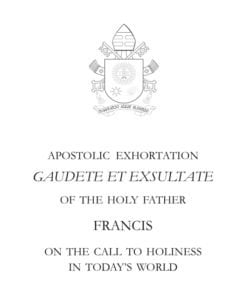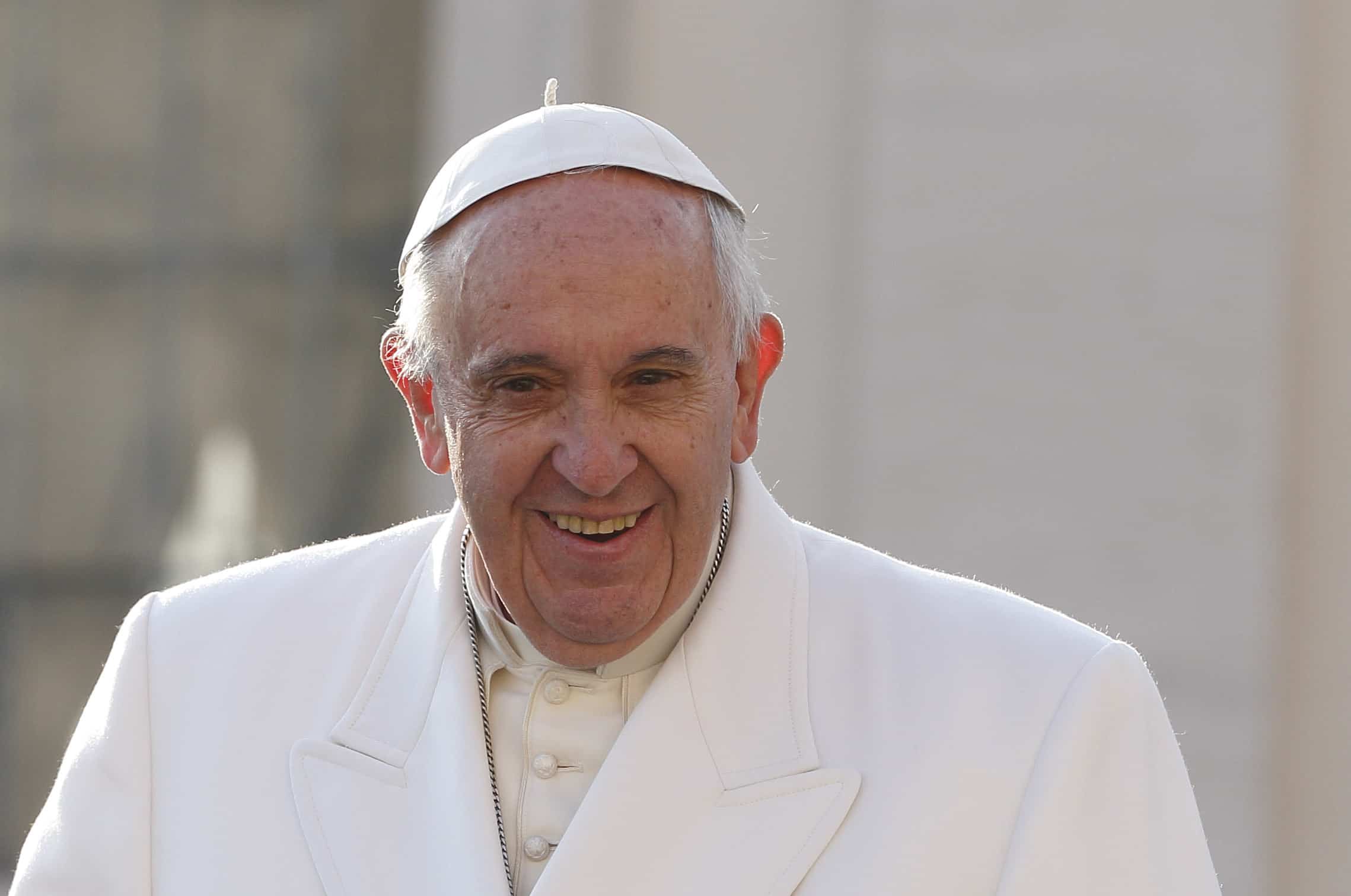Pope Francis is often called a “man of Vatican II.” In his newly-released Gaudete et Exsultate, he offers a powerful magisterial reflection on the Council’s “universal call to holiness”:
“Rejoice and be glad” (Mt 5:12), Jesus tells those persecuted or humiliated for his sake. The Lord asks everything of us, and in return he offers us true life, the happiness for which we were created. He wants us to be saints and not to settle for a bland and mediocre existence. (§1)
Gaudete et Exsultate (GE) is an apostolic exhortation, a type of document that ranks below an encyclical but above everyday papal homilies and speeches. It is the third one issued by Francis, after Evangelii Gaudium and Amoris Laetitia. Evangelii Gaudium has been roundly praised as a “charter” for Francis’ papacy, while Amoris Laetitia has been at the center of numerous controversies since its publication.
While GE is not likely to stir as much controversy as Amoris Laetitia, there is no question that it will be read with an eye toward pre-existing controversies. But no praise or criticism will do sufficient justice to GE that fails to recognize its simple premise: God calls us all to holiness.
Below TJP offers a summary and reader’s guide of GE. We hope it will inspire you to read the document yourself.

Introduction (§§1-2)
GE is meant to be practical: it is not “a treatise on holiness, containing definitions and distinctions helpful for understanding this important subject, or a discussion of the various means of sanctification.” Rather, it is a meditation on how to respond to Christ’s invitation to be saints: to “Rejoice and be glad,” (§1).
Chapter 1 (§§3-34): The Call to Holiness
In this chapter, Pope Francis discusses the diversity of forms under which holiness appears: “We are all called to be witnesses, but there are many actual ways of bearing witness,” (§11). Besides those saints and martyrs whose lives were “an exemplary imitation of Christ,” Pope Francis also praises “the middle class of holiness”: the everyday sanctity of “those parents who raise their children with immense love, in those men and women who work hard to support their families, in the sick, in elderly religious who never lose their smile,” (§7).
“The Holy Spirit bestows holiness in abundance among God’s holy and faithful people,” the Pope writes, which begins from baptism (§15). Here he invokes the theme of the universal call to holiness, citing Lumen Gentium §11: “all the faithful, whatever their condition or state, are called by the Lord – each in his or her own way – to that perfect holiness by which the Father himself is perfect”.
Pope Francis emphasizes the phrase “each in his or her own way,” for the diversity of forms of holiness means that Christians must discern how the Lord is calling each of them to holiness. While there are many good forms of life, every person has a unique vocation to whom he or she is called by God. Significantly, Pope Francis notes here that Saint John of the Cross “preferred to avoid hard and fast rules for all. He explained that his verses were composed so that everyone could benefit from them “in his or her own way”. For God’s life is communicated “to some in one way and to others in another”,”(§11). This will remind many of Francis’ constant insistence on the necessity of discernment and prudence concerning individual cases – a theme that many love about him and others find difficult to accept. But here he goes deeper: that particularity is requisite not just by the nature of discernment or morality, but by the nature of God’s very call to each human.
As he often does, Pope Francis makes specific mention of women in this section, both those holy women like Saint Hildegard of Bingen or Saint Teresa of Avila who emerged in times “when women tended to be most ignored or overlooked,” but also those “unknown or forgotten women” who nurture those around them in ways that we know have personally touched Pope Francis deeply (§12).
While everyone has a unique vocation, every mission “has its fullest meaning in Christ, and can only be understood through him,” (§20). Here Pope Francis is at his most Jesuit. To be Christian is to be a discipline of Christ, meaning to enter into the Gospel itself. “At its core, holiness is experiencing, in union with Christ, the mysteries of his life.” Contemplating the mysteries of Christ’s life, death and resurrection, “as Saint Ignatius of Loyola pointed out, leads us to incarnate them in our choices and attitudes,” (§20).
This section is in many ways tailored to the hopes expressed by young people at the Pre-Synodal Meeting this past March: “Young people understand the general sense of bringing meaning to life and being alive for a purpose, but many do not know how to connect that to vocation as a gift and call from God.” Pope Francis tells them in this exhortation: “You too need to see the entirety of your life as a mission,” (§23).
Chapter 2 (§§35-62): Two Subtle Enemies of Holiness
This chapter concerns “two false forms of holiness that can lead us astray: gnosticism and pelagianism,” (§35). This material will be largely familiar to those who follow this Papacy, and particularly to those who read the recent CDF Instruction Placuit Deo.
In the context of this exhortation, however, and in words that harken to Evangelii Gaudium, Pope Francis notably underlines how these tendencies draw oneself and others away from holiness:
whereby instead of evangelizing, one analyses and classifies others, and instead of opening the door to grace, one exhausts his or her energies in inspecting and verifying. In neither case is one really concerned about Jesus Christ or others”. §35
Also noteworthy: this section contains the most learned footnotes of the document, including citations of the Council of Trent; the Catechism; the Second Synod of Orange; Saints Augustine, Thomas Aquinas, Bonaventure, Thérèse of Lisieux and Pope John Paul II; and a dozen Scriptural citations. While these references are hardly unusual for a papal document, this section is at times more intellectual than the introduction to GE promises. These citations perhaps say something about the sort of readers the Holy Father is seeking to persuade in this section.
Chapter 3 (§§63-109): In the Light of the Master
Chapter 3 centers on the example of Jesus, particularly in an interpretation of the Beatitudes and Matthew 25. For while there “can be any number of theories about what constitutes holiness, with various explanations and distinctions… nothing is more enlightening than turning to Jesus’ words and seeing his way of teaching the truth,” (§63).
Pope Francis writes that “Jesus explained with great simplicity what it means to be holy when he gave us the Beatitudes (cf. Mt 5:3-12; Lk 6:20-23),” such that “The Beatitudes are like a Christian’s identity card,” (§63). The Beatitudes are thus our guide to doing what Francis urges us toward in Chapter 2, namely imitating Jesus. “For those faithful to God and his word, by their self-giving, gain true happiness,” he argues (§63) .
In this chapter, the Pope notes two “ideologies striking at the heart of the Gospel”: “those Christians who separate these Gospel demands from their personal relationship with the Lord, from their interior union with him, from openness to his grace,” and “those who suspect the social engagement of others, seeing it as superficial, worldly, secular, materialist, communist or populist,” (§100). The Church is more than an “NGO,” Francis argues, but one should also affirm the good of one’s neighbor as integral to the Christian life. Francis elaborates on this second point at some length, invoking St. Thomas Aquinas again to argue that “works of mercy towards our neighbour” give greater glory to God than even acts of worship (§106).
One of the most “Franciscan” moments in the text comes here:
Our defence of the innocent unborn, for example, needs to be clear, firm and passionate, for at stake is the dignity of a human life, which is always sacred and demands love for each person, regardless of his or her stage of development. Equally sacred, however, are the lives of the poor, those already born, the destitute, the abandoned and the underprivileged, the vulnerable infirm and elderly exposed to covert euthanasia, the victims of human trafficking, new forms of slavery, and every form of rejection. (§101)
Popes are pro-life, but not everyone sees Pope Francis as tough enough on this issue. His defense of “the innocent unborn” then, will be as surprising to those for whom it does not fit their narrative about Pope Francis. On the other hand, Francis underlines this defense to a vigilance for the whole human family, including the migrant (§102).
Francis ends this chapter with a bold statement. A life spent meditating on the Beatitudes and Matthew 25 and the examples of the saints “will benefit us; they will make us genuinely happy,” (§109).
Chapter 4 (§§110-157): Signs of Holiness in Today’s World
In Chapter 4, Pope Francis discusses five “great expressions of love for God and neighbour” that he takes to be “of particular importance in the light of certain dangers and limitations present in today’s culture.” Those “signs or spiritual attitudes” will help us “understand the way of life to which the Lord calls us.” Pope Francis first states these five attitudes negatively:
There we see a sense of anxiety, sometimes violent, that distracts and debilitates; negativity and sullenness; the self-content bred by consumerism; individualism and all those forms of ersatz spirituality – having nothing to do with God – that dominate the current religious marketplace. (§111)
Stated positively, the Christian should rather be patient and meek (§§112-121); joyful (§§122-128); bold and passionate (§§129-139); communal (§§140-146); and constantly prayerful (§§147-157). Pope Francis casts this chapter in terms of following and becoming more like Jesus, a life-long effort which leads us to and is sustained by the Eucharist:
In the Eucharist, the one true God receives the greatest worship the world can give him, for it is Christ himself who is offered. When we receive him in Holy Communion, we renew our covenant with him and allow him to carry out ever more fully his work of transforming our lives. (§157)
Chapter 5 (§§158-201): Spiritual Combat, Vigilance, and Discernment
The title of this chapter reminds us that the Pope is hard to put in a box: “spiritual combat” will sound old-fashioned and even reactionary for some. But Pope Francis makes no bones about his purpose in writing this way:
The Christian life is a constant battle. We need strength and courage to withstand the temptations of the devil and to proclaim the Gospel. This battle is sweet, for it allows us to rejoice each time the Lord triumphs in our lives. (§158)
Pope Francis continues that we “are not dealing merely with a battle against the world and a worldly mentality,” or “against our human weaknesses and proclivities… It is also a constant struggle against the devil, the prince of evil,” (§159). And the devil is real: “Hence, we should not think of the devil as a myth, a representation, a symbol, a figure of speech or an idea.” (§161) (Someone needs to send this section to Eugenio Scalfari.)
The spiritual life demands vigilance and keeping our “lamps lit” (§164). Progress in the spiritual life does not secure one from the devil’s snares. Indeed, the “spiritual corruption” of such persons “is worse than the fall of a sinner, for it is a comfortable and self-satisfied form of blindness,” (§165). While Pope Francis does not make this connection, one could imagine the Gnosticism and Pelagianism of Chapter 2 arising from this corruption.
Pope Francis ends the chapter by posing a question, the answer to which is his favorite subject. The question: “How can we know if something comes from the Holy Spirit or if it stems from the spirit of the world or the spirit of the devil?” The answer: discernment.
Discernment, of course, has been at the forefront of many discussions surrounding this papacy. At root is the question whether “some novelty… is new wine brought by God or an illusion created by the spirit of this world or the spirit of the devil.” But not only choosing new directions requires discernment, Francis urges, but also staying the course: “At other times, the opposite can happen, when the forces of evil induce us not to change, to leave things as they are, to opt for a rigid resistance to change.” Francis has spoken against the “rigidity” that he says often refuses to countenance needful change in Church disciplines. Such persons, he says, “block the working of the Spirit.” But “[w]e are free, with the freedom of Christ,” (§168).
Discernment, the Pope writes, should be exercised in matters great and small. Followers of this papacy will note that he takes this occasion to smuggle in again his favorite phrase in a footnote: “Non coerceri a maximo, conteneri tamen a minimo divinum est (“Not to be confined by the greatest, yet to be contained within the smallest, is truly divine”).
Discernment is “more than intelligence or common sense. It is a gift” from the Holy Spirit (§166). Indeed, while “spiritual discernment does not exclude existential, psychological, sociological or moral insights … it transcends them.” Further:
Nor are the Church’s sound norms sufficient. We should always remember that discernment is a grace. Even though it includes reason and prudence, it goes beyond them, for it seeks a glimpse of that unique and mysterious plan that God has for each of us, which takes shape amid so many varied situations and limitations. (§170)
Here we again see the Holy Father in dialogue with those who think his teaching on discernment does not sufficiently heed the normative force of Church teaching.
Moreover, it “is not about discovering what more we can get out of this life, but about recognizing how we can better accomplish the mission entrusted to us at our baptism,” (§174). Indeed, despite being mentioned explicitly only twice, baptism is a pervasive theme of this work: “Let the grace of your baptism bear fruit in a path of holiness,”(§15). Had this been an encyclical on the call to holiness, baptism might have figured more prominently in this text.
Finally, those conversant in Ignatian spirituality will appreciate the Pope’s admonition to pray “in dialogue with the Lord, a sincere daily “examination of conscience”,”(§169). Such an examen would be sterile were it not a discernment of spirits, and discernment would not be complete were it not the constant attitude of prayer that the examen fosters.
Conclusion (§§176-177) with Hail Mary
Pope Francis concludes by calling on Mary’s intercession to help all walk with Jesus toward holiness. Mary is a model for that holiness: “she lived the Beatitudes of Jesus as none other.” Her example is one of joy, discernment and suffering, and fidelity: “Mary is the saint among the saints, blessed above all others.” If we follow her example, Pope Francis urges, “we will share a happiness that the world will not be able to take from us.”
*****
In writing on the call to holiness, Pope Francis has given us a text on the reception of a fundamental Christian teaching, one that was profoundly reinforced by Vatican II. In this way, the document puts the Pope in very deep harmony with Scripture and Catholic tradition. Yet Pope Francis is himself deeply associated with this teaching, and GE shows why: Francis gives the call to holiness an earthy concreteness and beautifully humble instantiation in his own life. But we again run into what Chris Lowney calls the “Gandhi problem”: Pope Francis has given us a model. Will we follow it?
As with much that Pope Francis writes, there are many spiritual gems in GE, and many tantalizing possibilities for how it might be instantiated in the life of the Church. This pluripotency means that some will find it lacking in necessary clarity. Perhaps these may be the same people Pope Francis criticizes in Chapter 2. And Pope Francis will no doubt encourage such people to hacer lío in stating their concerns. But, as with many of his other writings, in GE Pope Francis sees the problems in the life of the Church not as theoretical, but as moral and spiritual. If there is a theoretical problem, he says, it has to do with the spiritual sickness of those who think they know what counts for holiness. This is perhaps why he wrote an apostolic exhortation, and not an encyclical.
The flashiest take-away from this document will be on discernment, and what it means for synodality, papal authority and the pastoral applications of Church teaching. I would like to close, however, with a thought on the tension in GE between “holiness of the middle class” and avoiding mediocrity. This is an important tension for Pope Francis, a man who exhorts us to give up everything for God and be like the saints, and yet who also worries that we don’t recognize and cherish sanctity in the ordinary.
On the one hand, Pope Francis wants us to see the holiness of those around us, of the people and in the places we already find ourselves among. On the other hand, Pope Francis asks us how that holiness can be known, loved, and practiced, so as to bring us closer to God. He nudges us, in other words, toward the magis. How appropriate that a Jesuit pope would lead us to see the intimate connection between the universal call to holiness and the magis of St. Ignatius of Loyola. For what else did Ignatius seek but holiness?


